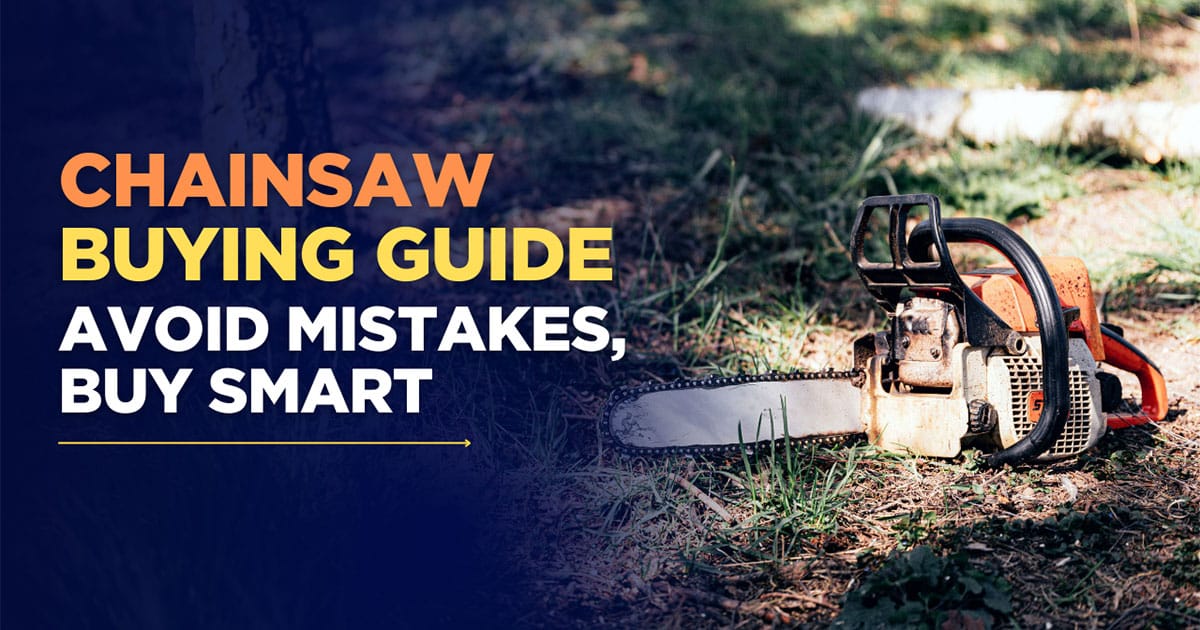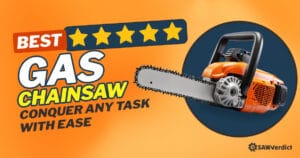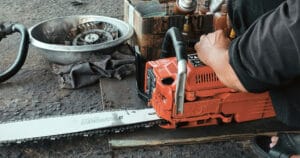A chainsaw is one of the most powerful and versatile tools for cutting wood, whether for tree felling, firewood preparation, or storm cleanup. With so many options on the market, choosing the right one can be overwhelming. This chainsaw buying guide will break down everything you need to know before making a purchase.
Did you know that the global chainsaw market is expected to reach $5.59 billion by 2034, driven by increasing demand from homeowners and professionals alike? With innovations in battery-powered chainsaws and eco-friendly electric models, there has never been a better time to invest in the right tool for your needs.
Whether you’re a DIYer, a farmer, or a professional logger, this guide will help you pick the perfect chainsaw based on power, safety, and budget.
If you’re looking for top-rated options, check out our Best Chainsaw: Top Picks for Power and Performance before diving into the details.
Keep reading to discover which type suits you best!
Key Takeaways
- Think about what you need before buying a chainsaw. Will you trim branches or cut down trees?
- Pick a chainsaw that matches your skill level. New users should choose light electric ones with safety features.
- Check where you’ll use the chainsaw. Quiet, cordless ones are good for cities, while gas ones work well in the countryside.
- Make sure it has safety features like chain brakes and anti-kickback to avoid accidents.
- Take care of your chainsaw. Clean it after every use and sharpen the chain every 5-10 hours to keep it working well.
- Choose a chainsaw that feels light and comfortable. A balanced diet helps you work longer without getting tired.
- Know why bar length matters. Pick the right size for your tasks to stay in control and work faster.
- Plan your spending carefully. Don’t forget to include safety gear and tools for upkeep in your budget.
Table of Contents
- 1 Assessing Your Needs
- 2 Types of Chainsaws
- 3 Key Factors to Think About When Buying a Chainsaw
- 4 Essential Features to Look For
- 5 Choosing the Right Chainsaw Based on the Use Case
- 6 Budget Considerations
- 7 Where to Buy a Chainsaw
- 8 Maintenance Tips for Longevity
- 9 Final Verdict
- 10 FAQ
- 10.1 What is the best chainsaw for beginners?
- 10.2 How often should you sharpen a chainsaw chain?
- 10.3 Can you use a chainsaw in wet conditions?
- 10.4 What type of oil should you use for a chainsaw?
- 10.5 How do you choose the right bar length?
- 10.6 Are gas chainsaws better than electric ones?
- 10.7 How do you maintain a chainsaw?
- 10.8 What safety gear do you need when using a chainsaw?
Assessing Your Needs
Picking the right chainsaw begins with knowing what you need. Whether trimming branches or cutting trees, think about your purpose, skill level, and surroundings. This helps you choose the best tool.

Define Your Purpose
Different chainsaws are made for different jobs. Knowing your task helps you decide.
Light-duty tasks
Light-duty chainsaws are great for small jobs like pruning shrubs. They are light and simple to use, perfect for homeowners or hobbyists. Cordless electric saws work well for trimming and pruning.
Want something lightweight but tough? Here’s our expert-approved list of the best mini chainsaws you can buy right now.
Medium-duty tasks
Medium-duty chainsaws are stronger and handle bigger jobs like cutting firewood. Gas-powered chainsaws are popular because they are powerful and last long. They are good for regular use without being too heavy.
Heavy-duty tasks
Heavy-duty chainsaws are for big jobs like cutting large trees. Big gas-powered chainsaws are very strong but hard to use in tight spaces. Professionals like loggers or arborists need these for tough tasks.
| Chainsaw Type | Best Use Case |
|---|---|
| Electric Cordless Saws | Small trimming and pruning |
| Petrol-Powered Chainsaws | Cutting medium or large trees |
| Small Portable Electric Saws | Light bush clearing in small areas |
| Large Petrol Saws | Hard to use in tight spots |
Consider Your Experience Level
Your skill level matters when picking a chainsaw. Beginners and experts need different tools.
Beginner-friendly options
If you’re new, pick a chainsaw with safety features like chain brakes. Lightweight electric chainsaws are easier to use and need less care. These are great for first-time users.
Advanced options
Experienced users like powerful chainsaws with extra features. Regular users often perform better with advanced tools. If you’re skilled, try a gas-powered chainsaw with adjustable settings.
Evaluate Your Environment
How you use the chainsaw also affects your choice. Urban and rural areas need different tools.
Urban or suburban settings
In cities, quiet and portable chainsaws are better. Cordless electric chainsaws are quieter and good for small spaces. They let you work without bothering the neighbors.
Want cleaner, quieter, and low-maintenance cutting power?
Dive into our Best Electric Chainsaws guide and discover which models truly deliver.
Rural or forested areas
In rural areas, you need strong chainsaws for big trees. Gas-powered chainsaws are best because they are powerful and work far from outlets.
Tip: Knowing your needs before buying a chainsaw saves money. Many chains are thrown away too soon but could be sharpened. Sharpening chains at home costs less than buying new ones.
Types of Chainsaws
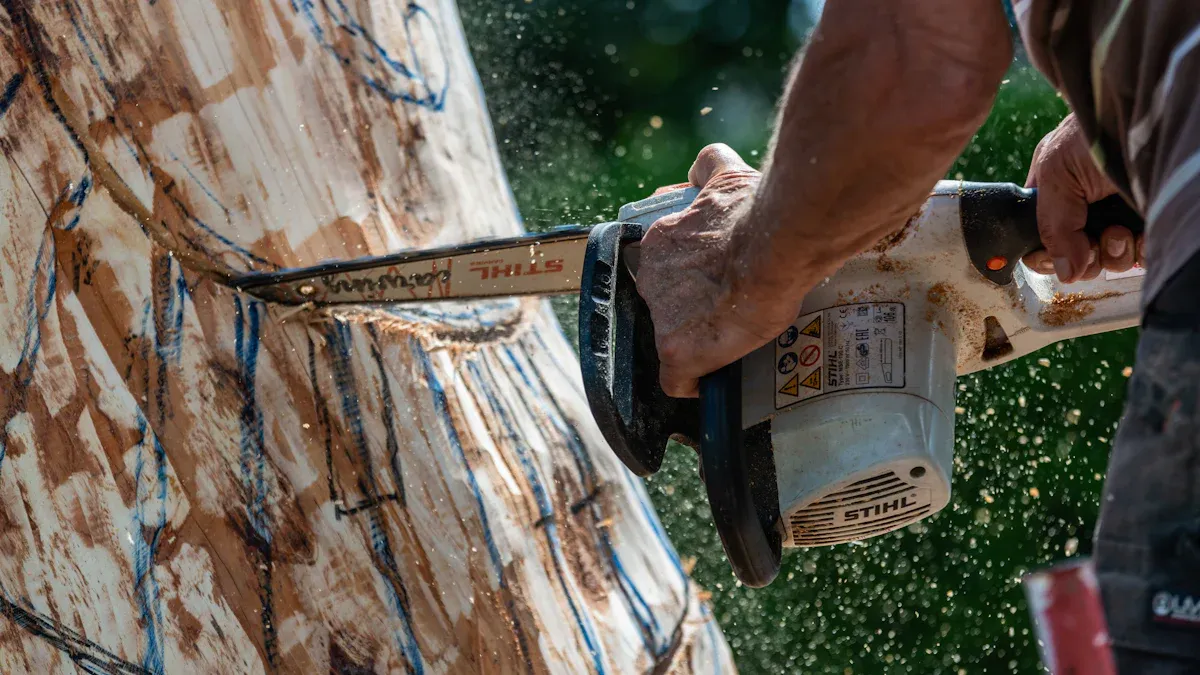
Picking the right chainsaw type is very important. Each kind has special features, good points, and limits. Knowing these will help you choose the best tool.
Gas Powered Chainsaw
Gas powered chainsaws are best for big jobs and professional work. They run on gas, making them strong and flexible.
Pros
- High Power Output: These chainsaws are very strong. They are great for cutting big trees and tough tasks.
- Unrestricted Mobility: No cords or batteries, which means you can use them anywhere. They work even in faraway places.
- Extended Operation Time: A full gas tank lets them run for hours without stopping.
Need a powerful tool that gets the job done fast? Check out our in-depth guide to the best gas chainsaws — perfect for heavy-duty yard work and professional use.
Cons
- Noise and Emissions: These chainsaws are loud and make smoke. They might not be good for cities or quiet neighborhoods.
- Maintenance Requirements: You need to clean and refuel them often to keep them working well.
- Weight: They are heavy, which can make you tired if used for a long time.
Electric Chainsaw
Electric chainsaws are quieter and better for the environment. You can choose between two options: corded or cordless.
Corded Options
Corded electric chainsaws are light and simple to use. They are good for small jobs like trimming and cutting firewood.
- Advantages:
- They have steady power as long as they are plugged in.
- No need to worry about running out of battery or gas.
- Limitations:
- You need a power outlet and a cord, which limits movement.
- Thick extension cords can be pricey and hard to handle.
Cordless Options
Cordless electric chainsaws use rechargeable batteries. They are great for small tasks where you need to move around easily.
- Advantages:
- No cords to get in your way.
- Easier to start and take care of than gas models.
- Limitations:
- Batteries can be heavy and expensive.
- They don’t last long and need recharging often for big jobs.
Consumer Insight: Cordless chainsaws are better than gas ones for small tasks. They give enough power without the trouble of using gas.
Battery Powered Chainsaw
Battery-powered chainsaws are a type of cordless electric chainsaw. They are becoming more popular because they are easy to use and eco-friendly.
Advantages
- Quiet Operation: These chainsaws are very quiet, so they’re good for homes.
- Low Maintenance: No need for gas or lots of repairs.
- Eco-Friendly: They don’t make harmful smoke, helping the environment.
Limitations
- Limited Runtime: Batteries last 20 to 60 minutes, depending on the model.
- Charging Time: Charging takes 30 minutes to 2 hours, based on the battery.
| Model | Runtime (minutes) | Charge Time (minutes) |
|---|---|---|
| Ego Power+ CS1800 | 60 | 90 |
| Husqvarna 120i | 40 (54 in Eco Mode) | 120 |
| Greenworks Pro 80V | 27 | 30 |
When picking a chainsaw, think about your tasks and where you’ll use it. Whether you need the strength of gas-powered models or the ease of battery-powered ones, knowing your options helps you choose wisely.
Manual and Pole Chainsaws
Chainsaws come in different types for various tasks. Manual and pole chainsaws are made for specific jobs. They are great for precise cuts or for reaching high branches. Knowing their features helps you decide if they suit your needs.
Manual saws
Manual chainsaws need your strength to cut wood. They are easy to carry, light, and cheap. Use them for small jobs like trimming branches or cutting thin logs. They are good for occasional use or as a backup tool.
Advantages of manual saws:
- Easy to carry: No need for gas or batteries.
- Affordable: They cost less and need little care.
- Environmentally safe: They don’t smoke or harm nature.
Limitations of manual saws:
- Tiring to use: You need strength to cut with them.
- Not powerful: They can’t cut thick or hardwood.
Tip: For small, light tasks, a manual saw is a smart and cheap choice.
Pole saws
Pole chainsaws help cut high branches without climbing. They have a long pole with a saw at the end. Use them to trim trees safely from the ground. They come in manual, electric, and gas-powered types.
Advantages of pole saws:
- Long reach: Cut branches 10–15 feet high while standing.
- Safer option: No need to climb trees or use ladders.
- More power: Electric and gas models cut thicker branches.
Limitations of pole saws:
- Heavy to hold: The long pole makes them harder to handle.
- Limited tasks: They are only good for cutting branches.
| Type of Pole Saw | Best Use Case | Power Source |
|---|---|---|
| Manual Pole Saw | Light pruning | Physical effort |
| Electric Pole Saw | Medium-duty trimming | Corded or cordless |
| Gas-Powered Pole Saw | Heavy-duty branch cutting | Gasoline |
Note: Think about tree height and branch size before picking a pole saw. Electric ones are good for cities, while gas ones work better in the countryside.
Manual and pole chainsaws are made for special jobs. A manual saw is simple and great for small tasks. Pole saws give you safety and reach when trimming trees. By knowing their pros and cons, you can pick the right tool for your work.
Key Factors to Think About When Buying a Chainsaw

When picking a chainsaw, focus on power, bar size, and comfort. These features affect how well it works and how safe it is. They are important for choosing the right tool.
Power and Engine Size
The power of a chainsaw shows how well it handles jobs. Gas chainsaws are rated by engine size (cc), while electric ones use voltage or wattage.
Gas engine ratings
Gas chainsaws are strong and great for tough jobs. Engine size matters:
- A 70 cc gas chainsaw cuts thick logs faster than a 40 cc one.
- Bigger engines give more power, which is perfect for cutting large trees.
But bigger engines are heavier and use more fuel. For most people, a 40- 50cc engine is a good mix of power and ease.
Electric motor ratings
Electric chainsaws use voltage (cordless) or wattage (corded). Higher ratings mean more power for medium tasks like cutting firewood. Cordless models with 40V batteries are easy to carry and use. For small jobs, a 15-amp corded chainsaw gives steady power without recharging.
Bar Length
The bar length shows how deep a chainsaw can cut. Picking the right size helps you work safely and efficiently.
Choosing the right size
Bars range from 10 to 20 inches or more. Small bars (10-14 inches) are good for trimming, while big bars (16+ inches) handle heavy jobs like cutting trees.
| Chainsaw Size | Bar Length (inches) | Best Uses |
|---|---|---|
| Small | 10 – 14 | Trimming, pruning, cutting small firewood |
| Medium | 14 – 16 | Home use, cutting bigger branches |
| Large | 16+ | Cutting big trees, heavy woodcutting |
Matching bar length to tasks
Shorter bars are easier to control and great for beginners. Longer bars are stronger but require more skill to be used safely. For yard work, a 14-inch bar is a good choice for balance and cutting.
Tip: Match the bar size to the wood you’ll cut. A short bar strains the saw, while a long bar can be hard to handle.
Weight and Comfort
The weight and balance of a chainsaw affect how easy it is to use, especially for long jobs.
Comfort and balance
A balanced chainsaw is easier to control and less tiring. Heavy chainsaws can make you tired fast. About 60% of users feel more tired using chainsaws over 12 pounds.
User Insight: “I used a chainsaw over 12 pounds once. After an hour, my arms were so tired. A lighter one let me work longer without getting worn out.”
Lightweight options
For small jobs, pick chainsaws under 10 pounds. They are easier to handle and good for beginners. Gas chainsaws are heavier, but electric and battery ones are lighter and still work well.
By thinking about these factors, you can find a chainsaw that fits your needs and works comfortably.
Safety Features
Chainsaws can be risky without proper safety features. Picking one with good safety tools lowers the chance of accidents. Here are two key features to check:
Chain brake and anti-kickback
A chain brake is very important for safety. It stops the chain fast if a kickback happens. Kickback occurs when the chain’s tip hits something, making the saw jerk back. This sudden movement can cause bad injuries. Anti-kickback chains and guide bars help reduce this danger by lowering the kickback force.
Throttle lock and handguards
A throttle lock makes sure the chainsaw only works when you press the trigger. This stops it from turning on by mistake when carrying or adjusting it. Handguards protect your hands from flying debris and accidental chain contact. These features make using a chainsaw safer and easier to control.
Tip: Always look for these safety features before buying a chainsaw. They can help prevent serious accidents.
Ease of Maintenance
Taking care of your chainsaw keeps it working well and lasting longer. Choosing one with easy maintenance features saves time and effort. Here are two helpful options:
Tool-free chain tensioning
Chainsaws need regular chain tension adjustments to work smoothly. Models with tool-free chain tensioning let you adjust the chain quickly without extra tools. This is great for beginners or anyone wanting to save time.
Note: Correct chain tension stops the chain from slipping or breaking. This protects the saw and keeps you safe.
Automatic oiling systems
Chainsaws need oil to keep the chain moving smoothly. Automatic oiling systems add the right amount of oil to the chain and bar. This reduces wear and tear and removes the need for manual oiling, making maintenance easier.
| Research Question | Description |
|---|---|
| 1 | Do companies fully use the lifespan of chainsaw chains? |
| 2 | If not, how often are chains retired too early? |
| 3 | How do location and time affect the costs of chainsaw chains? |
| 4 | What methods can improve chain sharpening and maintenance efficiency? |
Pro Tip: Chainsaws with automatic oiling and tool-free tensioning are perfect for users who want less hassle and more cutting.
By focusing on safety and easy maintenance, you can pick a chainsaw that is safe, effective and lasts a long time.
Essential Features to Look For
Some features make working with a chainsaw easier and safer. Knowing these features helps you choose the right tool for better results.
Chain Speed and Cutting Performance
The chain’s speed affects how fast and smoothly it cuts wood. Faster chains save time and effort, especially for thick logs or big branches. If you often cut large wood, a high-speed chainsaw will help you finish faster.
Efficiency and task needs
Chainsaws with faster chains work better for tough jobs. Tests show how different models perform:
| Chainsaw Model | Average Cut Time (seconds) | Wind-up Time (seconds) | Performance Notes |
|---|---|---|---|
| EGO Power+ CS2005 | 1.5 seconds faster than others | N/A | Cuts smoothly, like slicing soft butter. |
| Echo CS 590 Timber Wolf | 4.9 seconds | N/A | Best gas model, great for cutting big logs. |
The EGO Power+ CS2005 is great for homeowners needing quick, smooth cuts. The Echo CS 590 Timber Wolf is perfect for professionals handling heavy tasks. Think about the wood type and the time you want to spend before choosing.
Tip: For small jobs like pruning, you don’t need the fastest chain. But for big logs, a high-speed chainsaw works best.
Automatic vs. Manual Chain Oiling
A lubricated chain lasts longer and works better. Chainsaws have automatic or manual oiling systems, each with pros and cons.
| Feature | Automatic Systems | Manual Systems |
|---|---|---|
| Efficiency | Riskier near-moving parts | Can waste oil, less accurate |
| Productivity | Oils while running | Requires stopping to add oil |
| Worker Safety | Keeps hands away from moving parts | Riskier near moving parts |
| Cost Efficiency | Uses less oil over time | Often uses more oil |
Automatic oiling adds oil as you work, saving time and reducing wear. Manual oiling requires you to stop and apply oil, which slows you down. Automatic systems are also safer since your hands stay away from moving parts.
Pro Tip: For less hassle, pick a chainsaw with automatic oiling. It saves time and keeps your tool in good shape.
Tool-Free Chain Adjustment
Chainsaws need regular chain tension checks for safe and smooth cutting. A loose chain can fall off, and a tight one can harm the motor. Models with tool-free adjustments make this easy and quick.
Tool-free systems use a knob or lever to adjust the chain. You don’t need extra tools, making it great for beginners or anyone wanting simple maintenance. This feature also lets you fix the chain anytime, keeping your chainsaw ready to use.
Note: Always check chain tension before starting. Proper tension improves cutting and prevents accidents.
By focusing on these features, you’ll find a chainsaw that’s easy to use, safe, and efficient. Whether for home or professional use, these features make your work smoother and more productive.
Vibration Reduction and Handling
Using a chainsaw can cause strong vibrations. These vibrations might make you uncomfortable or harm your health over time. Picking a chainsaw with vibration-reducing features makes it safer and easier to use.
Anti-vibration systems
Many modern chainsaws have anti-vibration systems. These systems lower the shaking that reaches your hands and arms. They help prevent health problems like Raynaud’s syndrome, which happens from too much vibration. Studies show why these systems are important:
| Study Title | Findings | Recommendations |
|---|---|---|
| The risk analysis at working with a chainsaw | The risk analysis of working with a chainsaw | Use anti-vibration systems to lower hand-arm vibration exposure. |
| Evaluation of hand-transmitted chainsaw vibrations during wood-cutting | Chainsaw vibrations can harm health, causing trepidation disease. | Better handle designs and vibration controls are needed. |
When buying a chainsaw, choose one with built-in anti-vibration features. These systems protect your health and make the tool easier to use for longer periods.
Handle design
The handle design of a chainsaw is very important. It helps reduce tiredness and gives you better control. Handles with soft grips absorb vibrations and feel more comfortable. A good handle lets you hold the chainsaw firmly, lowering accident risks.
Look for a chainsaw with a front handle that offers different grip positions. This helps when cutting at various angles. A balanced handle also spreads the weight evenly, making it simpler to move around.
Tip: Try holding the chainsaw before buying it. A comfy handle can make your work much easier.
Warranty and Longevity
Buying a chainsaw is a long-term choice. Knowing about warranties and what affects their lifespan helps you pick wisely.
Warranty periods
Warranties for chainsaws differ by type and brand. Gas-powered chainsaws often have longer warranties because they are sturdier. Electric chainsaws may have shorter warranties, but newer models are becoming more reliable.
- Gas chainsaws: Warranties last 2-5 years, showing strong build quality.
- Electric chainsaws: Warranties range from 1-3 years, with better durability in newer models.
A longer warranty means the company trusts its product and gives you peace of mind.
Factors affecting lifespan
Taking care of your chainsaw helps it last longer. Clean the chain, sharpen it, and check its tension often. Features like automatic oiling and tool-free adjustments make maintenance easier and extend the tool’s life.
Other things that affect how long a chainsaw lasts include:
- Build quality: Strong materials make the tool last longer.
- Usage frequency: Using it often means more care is needed.
- Storage conditions: Keep it in a dry, clean place to avoid rust.
Pro Tip: Follow the care instructions from the maker. A well-maintained chainsaw works better and lasts longer.
By focusing on vibration control, good handle design, and warranty details, you can pick a chainsaw that is comfortable and durable. These features make it safer and more enjoyable to use, whether for home or professional tasks.
Choosing the Right Chainsaw Based on the Use Case
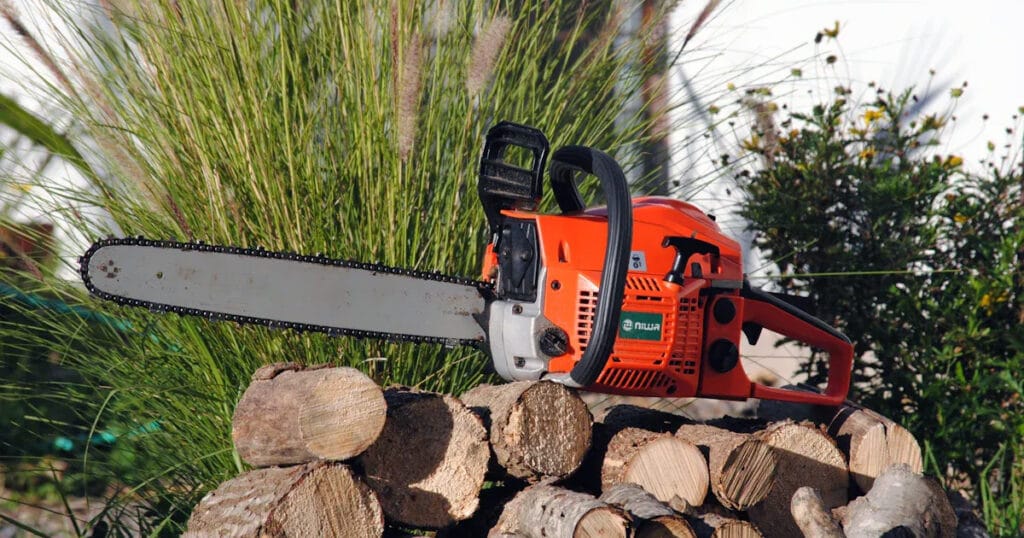
For Homeowners & DIYers
Homeowners and DIY fans need chainsaws for small tasks. These include trimming branches, pruning shrubs, or cutting small firewood. Lightweight chainsaws are easier to use for these jobs. Electric chainsaws, especially cordless ones, are quiet and need little care. They let you focus on your work without worrying about gas or hard maintenance.
Safety is very important when picking a chainsaw. Look for features like chain brakes and anti-kickback tools. These help prevent accidents, especially for beginners. A bar length of 10 to 14 inches is enough for most home tasks. This size is easier to control and handle for new users.
Tip: Choose chainsaws with tool-free chain tensioning. It makes adjustments quick and easy for your projects.
For Farmers & Ranchers
Farmers and ranchers need chainsaws for medium tasks like cutting firewood or clearing land. Gas-powered chainsaws with 16 to 18-inch bars are strong and durable. They can handle tough wood and long-cutting jobs without overheating.
Comfort matters when using chainsaws for a long time. Heavy chainsaws make users tired faster. Pick models with vibration-reducing features for better comfort. Husqvarna chainsaws, like the Husqvarna 440, are powerful and reduce work time. They are great for long and tough tasks.
Looking for the best Husqvarna chainsaw for any job?
Don’t miss our in-depth guide on the Best Husqvarna Chainsaw: Top Picks for Any Task – from heavy-duty logging to simple backyard tasks, we’ve reviewed the top models that get the job done right.
- Key Features for Farmers & Ranchers:
- Medium bar length (16–18 inches) for flexibility.
- Vibration reduction for less fatigue during long use.
- Strong build for frequent and tough jobs.
Pro Tip: Keep your chainsaw in good shape by sharpening the chain and cleaning the bar often.
For Professionals & Loggers
Professional loggers need chainsaws for heavy-duty work. These chainsaws must be strong, durable, and efficient for cutting big trees. Gas-powered chainsaws with engines over 50cc and bars 20 inches or longer are best for these jobs.
Special features can improve work speed and save money. For example, sharpening chains in one place and buying chains near suppliers reduces downtime. Studies show that saw performance, ease of use, and power are the most important features for loggers.
| Metric | Weight (%) |
|---|---|
| Saw Performance | 35% |
| Ease of Use | 30% |
| Power Performance | 25% |
| Noise | 5% |
| Weight | 5% |

When picking a chainsaw, choose one with advanced safety tools and fast cutting speeds. These features make work safer and more productive.
Note: Buying a high-quality chainsaw with special features saves time and money over time.
For Arborists & Tree Surgeons
Arborists and tree surgeons need chainsaws that are precise and efficient. Their work often involves climbing trees, working in tight spots, and making careful cuts. Picking the right chainsaw helps you stay safe, avoid getting tired, and work faster. This guide will help you find the best tool for your tasks.
Key Features for Arborists
Small and light chainsaws are perfect for tree work. A bar length of 12 to 16 inches makes it easier to move in small spaces. Top-handle chainsaws give better control when working high up. Anti-vibration systems also make long jobs less tiring.
Safety is very important for arborists. Chain brakes and low-kickback chains help prevent accidents. Throttle locks and handguards add extra safety. These features are especially useful when working on ladders or in tree branches.
Tip: Pick a chainsaw with a lanyard attachment. It keeps the tool secure while climbing and stops it from falling.
Economic Considerations
Taking care of your chainsaw saves money. Studies show 77% of chains are replaced too soon. Chains can often be sharpened 4 to 5 more times before needing replacement. Sharpening chains yourself costs much less than buying new ones. This makes sharpening a smart way to save money.
| Finding | Details |
|---|---|
| Chains Retired Early | 77% of chains are replaced too soon. |
| Additional Sharpening | Chains can be sharpened 4 to 5 more times. |
| Cost Comparison | Buying new chains costs 3 to 5 times more than sharpening. |
| Economic Cost | Sharpening at home is 2 to 4 times cheaper than buying new chains. |
Sharpening chains often keeps them working well and saves money. It also helps your chainsaw cut better, which is important for tree work.
Recommended Chainsaw Types
Battery-powered chainsaws are great for arborists. They are light, quiet, and better for the environment. These are good for pruning and small to medium cuts. Gas-powered chainsaws are stronger and better for cutting big branches or trees. Choose one with a quick-start feature to save time on tough jobs.
Note: Match the chainsaw’s power and bar size to your tasks. A tool that’s too strong can be hard to control, while a weak one might slow you down.
By choosing the right chainsaw, you can work safely and efficiently. Small, easy-to-handle tools with good safety features make an arborist’s job much simpler.
Budget Considerations

When buying a chainsaw, knowing your budget is very important. Chainsaws come in different price ranges, and extra costs like safety gear and tools can add up. Planning ahead helps you buy smart without spending too much.
Price Ranges
Chainsaws have different prices based on their features and power. Here’s a simple guide to help you pick:
Entry-level models
Entry-level chainsaws are great for small jobs like trimming branches. They are cheap and easy to use, perfect for beginners. Most electric or battery-powered models fit here.
- Price Range: $50–$150
- Features: Light, short bar (10–14 inches), basic safety tools.
- Best For: Homeowners and DIYers doing light yard work.
Mid-range options
Mid-range chainsaws are stronger and last longer. They handle medium tasks like cutting firewood or clearing small trees. Gas-powered models are common in this group because they are powerful and flexible.
- Price Range: $150–$400
- Features: Longer bar (14–18 inches), better vibration control, and improved safety.
- Best For: Farmers, ranchers, or regular users needing reliable tools.
High-end models
High-end chainsaws are made for tough jobs and professionals. They are very strong, durable, and have advanced features. These are often gas-powered with big engines and long bars.
- Price Range: $400 and above
- Features: Bars over 20 inches, anti-vibration systems, and faster cutting.
- Best For: Loggers, arborists, and people doing large projects.
Tip: Pick a chainsaw that fits your tasks. Spending extra on features you don’t need wastes money.
Additional Costs
Buying a chainsaw isn’t the only cost. Adding extra expenses to your budget helps you stay prepared.
Safety gear
Safety gear is a must when using a chainsaw. Items like helmets, gloves, and goggles protect you from accidents. Chainsaw chaps shield your legs from kickback or chain injuries.
- Estimated Cost: $50–$200
- Must-Have Items:
- Helmet with face shield
- Cut-resistant gloves
- Chainsaw chaps
- Steel-toe boots
Note: Spending on safety gear lowers the chance of injuries and medical bills.
Accessories
Accessories make your chainsaw work better and last longer. Common items include spare chains, sharpening kits, and oil. Regular care keeps your tool in good shape.
- Estimated Cost: $20–$100 per year
- Common Accessories:
- Extra chains
- Chain Sharpening Tools
- Bar and chain oil
| Chain Management Method | Average Cost (CAD) | Cost Comparison Ratio |
|---|---|---|
| Buying a new chain | $31.92 | 4.26 times costlier than sharpening at home |
| Sharpening at home | $7.49 | N/A |
| Professional sharpening | $17.83 | 2.38 times costlier than sharpening at home |

Pro Tip: Sharpening chains at home saves money. It’s much cheaper than buying new chains or hiring professionals.
By knowing price ranges and extra costs, you can plan your budget well. Whether you’re a beginner or a pro, understanding these details helps you get the best value for your money.
Where to Buy a Chainsaw
Finding the best place to buy a chainsaw makes shopping easier. You can choose between online stores or local shops. Each option has its own benefits, so knowing them helps you decide.
Amazon vs. Home Depot vs. Local Dealers
When buying a chainsaw, you might look at Amazon, Home Depot, or local dealers. Each has something special to offer.
- Amazon:
Amazon has many chainsaws, from beginner to expert models. You can read reviews to see what others think. Delivery to your home is very convenient. But, you can’t check the product in person before buying. - Home Depot:
Home Depot lets you shop online or in-store. You can see the chainsaw in person and get advice from staff. They also fix some models if needed. However, they may not have as many brands as other places. - Local Dealers:
Local dealers focus on outdoor tools and often sell top brands. You can try the chainsaw before buying. They also help with repairs and maintenance. But, their prices are usually higher, and they have fewer options.
| Platform | Key Benefits | Limitations |
|---|---|---|
| Amazon | Many choices, reviews, home delivery | No in-person inspection |
| Home Depot | Staff advice, repair services | Fewer brands available |
| Local Dealers | Expert help, test before buying | Higher cost, smaller selection |
Tip: Test a chainsaw at a local dealer if unsure. Then, compare prices online to save money.
Benefits of Buying Online
Buying a chainsaw online has many perks. It’s a simple and fast way to shop.
- More Choices:
Websites like Amazon and Home Depot have more chainsaws than most local stores. You can find one for any budget or job. - Reviews Help:
Reading reviews shows how well a chainsaw works for others. Look for comments about safety, ease of use, and durability. - Compare Prices:
Online shopping lets you check prices on different sites. You might find discounts or deals not offered in stores. - Easy Shopping:
You can shop from home and save time. Many websites even offer free shipping.
What to Check Before Purchasing
Before buying a chainsaw, online or offline, check a few things. These steps help you pick the right tool.
- Features:
Check the power, bar size, and weight. Make sure they fit your tasks. - Warranty:
Look at the warranty length and what it covers. A longer warranty often means better quality. - Return Rules:
Make sure you can return the chainsaw if it doesn’t work for you. This is important for online buys. - Extras:
Some chainsaws come with spare parts or cases. These extras add value. - Support:
Good customer service is helpful for repairs or questions. Check if the seller offers help after you buy.
Note: Read the product details carefully when shopping online. Double-check the model and features to avoid mistakes.
By knowing where to shop and what to check, you can pick the best chainsaw. Whether you like online deals or local advice, these tips will help you make a smart choice.
Maintenance Tips for Longevity
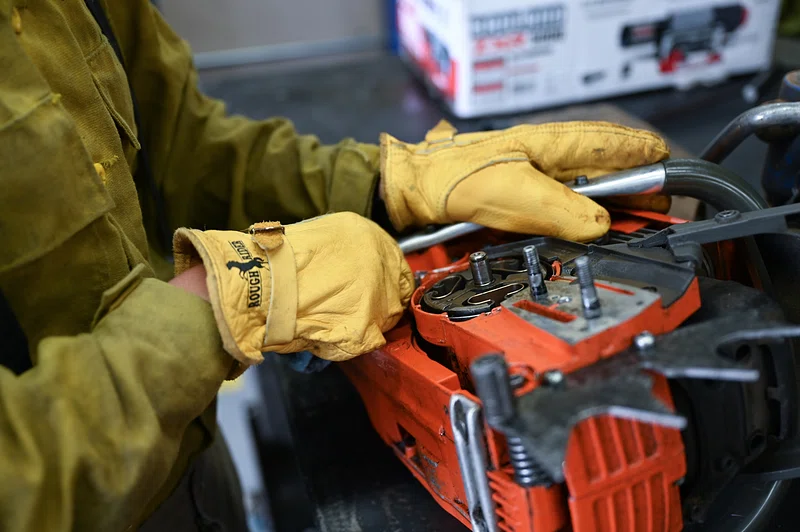
Proper maintenance keeps your chainsaw running efficiently and extends its lifespan. Regular care also ensures safety and reduces the risk of unexpected breakdowns. Follow these tips to keep your chainsaw in top condition.
Regular Cleaning and Inspection
Chainsaws collect dirt, sawdust, and oil during use. Cleaning and inspecting your tool regularly prevents buildup and ensures smooth operation.
Cleaning the chain and bar
Clean the chain and bar after every use. Remove sawdust and debris using a brush or compressed air. Wipe the bar with a cloth to remove oil and dirt. A clean chain cuts better and reduces wear on the motor.
- Why it matters: Studies show that chains often last longer than expected with proper cleaning and maintenance. Regular cleaning improves cutting performance and reduces downtime.
Checking for wear
Inspect your chainsaw for signs of wear. Check the chain for dull teeth or damage. Look at the bar for cracks or uneven wear. Examine the trigger, throttle lockout, and chain catcher to ensure they work properly.
- Checklist for inspection:
- Clean external parts.
- Check the chain catcher for damage.
- Inspect bolts and screws for tightness.
Tip: Regular inspections help you catch small issues before they become big problems.
Sharpening the Chain
A sharp chain cuts faster and requires less effort. Dull chains slow you down and strain the motor.
Tools needed
You’ll need a round file, a file guide, and a depth gauge tool to sharpen your chain. These tools ensure precision and keep the chain in optimal condition.
Frequency of sharpening
Sharpen your chain after every 5–10 hours of cutting. If you notice the chain pulling or producing fine sawdust instead of wood chips, it’s time to sharpen. Clean the air filter and tighten bolts during this routine.
- Sharpen the chain teeth after every 5–10 hours of use.
- Clean the air filter regularly.
- Check and tighten all bolts and screws.
Pro Tip: Keep a spare chain handy. Swap it out when sharpening isn’t possible during a job.
Proper Storage
Storing your chainsaw correctly prevents rust and keeps it ready for use.
Storing safely
Store your chainsaw in a dry, cool place. Use a protective case or cover to shield it from dust and moisture. Keep it out of reach of children and pets.
Draining fuel for storage
If you won’t use your chainsaw for a while, drain the fuel tank. Old fuel can clog the engine and reduce performance. Run the chainsaw until it stops to clear any remaining fuel.
Note: Always store your chainsaw with the chain brake engaged for added safety.
By following these maintenance tips, you’ll ensure your chainsaw stays reliable and efficient for years. Regular care not only saves money but also keeps your tool performing at its best.
Final Verdict
Choosing the right chainsaw doesn’t have to be complicated. Whether you need a gas-powered chainsaw for heavy-duty work, an electric model for home use, or a battery-powered option for convenience, there’s a perfect tool for every job.
This chainsaw buying guide has covered everything from power types and safety features to the best options based on your needs. Remember to consider factors like engine size, bar length, weight, and maintenance before making your purchase.
For homeowners and occasional users, a lightweight electric or battery-powered chainsaw is a great choice. Professionals and farmers may benefit from a high-performance gas chainsaw with a longer bar.
Ready to find the best chainsaw for you? Check out our top recommendations and make an informed choice that fits your budget and cutting needs!
FAQ
What is the best chainsaw for beginners?
Choose a lightweight electric or battery-powered chainsaw with safety features like chain brakes and anti-kickback. A bar length of 10–14 inches works well for small tasks. These models are easier to handle and maintain.
How often should you sharpen a chainsaw chain?
Sharpen the chain after every 5–10 hours of use. If the chain produces fine sawdust instead of wood chips, it’s time to sharpen. Regular sharpening improves cutting performance and extends the chain’s lifespan.
Can you use a chainsaw in wet conditions?
Avoid using a chainsaw in heavy rain or wet conditions. Wet wood increases the risk of slipping, and water can damage electric chainsaws. Always prioritize safety and wait for dry conditions when possible.
What type of oil should you use for a chainsaw?
Use bar and chain oil specifically designed for chainsaws. This oil reduces friction and keeps the chain running smoothly. Avoid using motor oil or other substitutes, as they can damage the tool.
How do you choose the right bar length?
Match the bar length to your tasks. For trimming and pruning, use 10–14 inches. For cutting firewood or medium trees, 14–18 inches works best. Longer bars (20+ inches) are ideal for heavy-duty jobs like felling large trees.
Are gas chainsaws better than electric ones?
Gas chainsaws are more powerful and suitable for heavy-duty tasks. Electric chainsaws are quieter, lighter, and better for small to medium jobs. Your choice depends on the type of work and your experience level.
How do you maintain a chainsaw?
Clean the chain and bar after each use. Check for wear, tighten bolts, and ensure proper chain tension. Use the correct oil and store the chainsaw in a dry place. Regular maintenance keeps it running efficiently.
What safety gear do you need when using a chainsaw?
Wear a helmet with a face shield, cut-resistant gloves, chainsaw chaps, and steel-toe boots. These items protect you from flying debris, kickbacks, and accidental cuts. Safety gear is essential for reducing injury risks.

